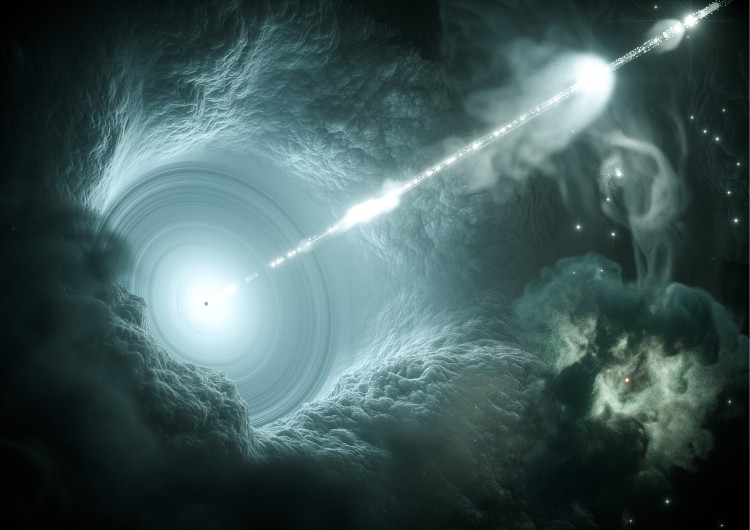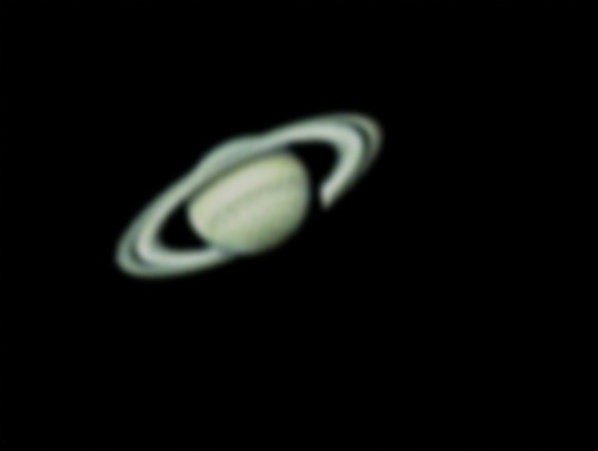Natural Particle Accelerators in Space Leave the Large Hadron Collider Energies in the Dust

Artist's impression of an Active Galactic Nucleus (AGN). The supermassive black hole at the center of the accretion disk sends a narrow high-energy jet of matter into space, perpendicular to the disc creating what we observe on Earth as High Energy Cosmic Rays. Since cosmic rays (or more appropriately cosmic particles) were first discovered in 1912 by Victor Hess, scientists have sought the origins of these mysterious particles. In September 2017, a flash of blue light in the ice deep beneath the South Pole set researchers on a path to resolving this century-old riddle. The international team found the first evidence of a source of high-energy cosmic neutrinos, a ghostly subatomic particle that can travel in a straight line for billions of light years, passing unhindered through galaxies, stars and anything else nature throws in its path. The observation, made by the IceCube Neutrino Observatory at the Amundsen-Scott South Pole Station, helped resolve a more than century-old riddle about what sends subatomic particles such as neutrinos and high-energy cosmic rays speeding through the universe. (Content Credit: Deutsches Elektronen-Synchrotron - DESY) (Image Credit: DESY, Science Communication Lab)
Natural Particle Accelerators in Space Leave the Large Hadron Collider Energies in the Dust
Since they were first detected more than a hundred years ago, Cosmic Rays – highly energetic particles that continuously rain down on Earth from space – have posed an enduring mystery. What creates and propels the particles across vast distances? Where do they come from? Using an internationally organized effort, scientist have for the first time located a source of high-energy cosmic neutrinos -- ghostly elementary cosmic particles that travel billions of light years through the universe, flying unaffected through stars, planets, and entire galaxies. The joint observation campaign was triggered by a single neutrino that was recorded by the IceCube Neutrino Telescope at the South Pole in September 2017. The energy of this specific neutrino was around 300 Tera-ElectronVolts – That is more than 40 times the energy produced by the world’s largest particle accelerator, the CERN Large Hadron Collider (LHC) in Switzerland. Telescopes on Earth and in space were able quickly follow-up the initial detection with more detailed observations that determined the exotic particle had originated in a galaxy nearly four billion light years away in the constellation Orion, where a gigantic black hole was behaving like a natural particle accelerator.
The observation campaign, in which research scientists from around the world played a key role, is a decisive step towards solving a riddle that has been puzzling scientists for over 100 years, namely that of the precise origins of so-called cosmic rays, high-energy subatomic particles that are constantly bombarding Earth’s atmosphere. “This is a milestone for the budding field of neutrino astronomy. We are opening a new window into the high-energy universe,” says Marek Kowalski, the head of Neutrino Astronomy at Deutsches Elektronen-Synchrotron (DESY), a research center of the Helmholtz Association, and a researcher at Humboldt University in Berlin. “The concerted observational campaign using instruments located all over the globe is also a significant achievement for the field of multi-messenger astronomy -- that is the investigation of cosmic objects using different messengers, such as electromagnetic radiation, gravitational waves, and neutrinos.”
Messengers from the high-energy universe
One way in which scientists expect energetic neutrinos to be created is as a sort of by-product of cosmic rays, which are expected to be produced in cosmic particle accelerators, such as the vortex of matter created by supermassive black holes or exploding stars. However, unlike the electrically charged particles of cosmic rays, neutrinos are electrically neutral and therefore not deflected by cosmic magnetic fields as they travel through space, meaning that the direction from which they arrive points straight back at their actual source. Also, neutrinos are scarcely absorbed. “Observing cosmic neutrinos gives us a glimpse of processes that are opaque to electromagnetic radiation,” says Klaus Helbing from the Bergische University of Wuppertal, spokesperson for the German IceCube network.“Cosmic neutrinos are messengers from the high-energy universe.”
Demonstrating the presence of neutrinos is extremely complicated, however, because most of the ghostly particles travel right through the entire Earth without leaving a trace. Only on very rare occasions does a neutrino interact with its surroundings. It therefore takes huge detectors in order to capture at least a few of these rare reactions. For the IceCube detector, an international consortium of scientists headed by the University of Wisconsin in Madison (USA) drilled 86 holes into the Antarctic ice, each 2500 meters deep. Into the holes they lowered 5160 light sensors, spread out over a total volume of one cubic kilometer. The sensors register the tiny flashes of light that are produced during the rare neutrino interactions in the transparent ice.
Five years ago, IceCube furnished the first evidence of high-energy neutrinos from the depths of outer space. However, these neutrinos appeared to be arriving from random directions across the sky. “Up to this day, we didn’t know where they originated,” says Elisa Resconi from the Technical University of Munich, whose group contributed crucially to the findings. “Through the neutrino recorded on 22 September 2017, we have now managed to identify a first source.”
From radio waves to gamma radiation
The energy of the neutrino in question was around 300 Tera-ElectronVolts, more than 40 times that of the protons produced in the world’s largest particle accelerator, the Large Hadron Collider at the CERN facility outside Geneva. Within minutes of recording the neutrino, the IceCube detector automatically alerted numerous other astronomical observatories. A large number of these then scrutinized the region in which the high-energy neutrino had originated, scanning the entire electromagnetic spectrum: from high-energy gamma and X-rays, through visible light, to radio waves. Sure enough, they were able for the first time to assign a celestial object to the direction from which a high-energy cosmic neutrino had arrived.
“In our case, we saw an active galaxy, which is a large galaxy containing a gigantic black hole at its center,” explains Kowalski. Huge “jets” shoot out into space at right angles to the massive vortex that sucks matter into the black hole. Astrophysicists have long suspected that these jets generate a substantial proportion of cosmic particle radiation. “Now we have found key evidence supporting this assumption,” Resconi emphasises.
The active galaxy that has now been identified is a so-called blazar, an active galaxy whose jet points precisely in our direction. Using software developed by DESY researchers, the gamma-ray satellite Fermi, operated by the US space agency NASA, had already registered a dramatic increase in the activity of this particular blazar, whose catalogue number is TXS 0506+056, around 22 September 2017. Now, an earthbound gamma-ray telescope also recorded a signal from it. “In the follow-up observation of the neutrino, we were able to observe the blazar in the range of very high-energy gamma radiation too, using the MAGIC telescope system on the Canary Island La Palma,” says DESY’s Elisa Bernardini, who coordinates the MAGIC observations. “The gamma-rays are closest in energy to neutrinos and therefore play a crucial role in determining the mechanism by which the neutrinos are created.” The program for the efficient follow-up observation of neutrinos using gamma-ray telescopes was developed by Bernardini’s group.
The NASA X-ray satellites Swift and NuSTAR also registered the eruption of the blazar, and the gamma-ray telescopes HESS, HAWC, and VERITAS as well as the gamma-ray and X-ray satellites AGILE, belonging to the Italian Space Agency ASI, and Integral, belonging to the European Space Agency ESA, all took part in the follow-up observations. All in all, seven optical observatories (the ASAS-SN, Liverpool, Kanata, Kiso Schmidt, SALT, and Subaru telescopes, as well as the Very Large Telescope VLT of the European Southern Observatory, ESO) observed the active galaxy, and the Karl G. Jansky Very Large Array (VLA) studied its activity in the radio spectrum. This led to a comprehensive picture of the radiation emitted by this blazar, all the way from radio waves at the low end of the spectrum to gamma-rays at the high end that carry up to 100 billion times as much energy.
Search in archives reveals further neutrinos
A worldwide team of scientists from all the groups involved worked flat out, conducting a complicated statistical analysis to determine whether the correlation between the neutrino and the gamma-ray observations was perhaps just a coincidence. “We calculated that the probability of it being a mere coincidence was around 1 in 1000,” explains DESY’s Anna Franckowiak, who was in charge of the statistical analysis of the various different data sets. This may not sound very large, but it is not small enough to quell the professional skepticism of physicists.
A second line of investigation rectified this. The IceCube researchers searched through their data from the past years for possible previous measurements of neutrinos coming from the direction of the blazar that had now been identified. And they did indeed find a distinct surplus of more than a dozen of the ghost particles arriving from the direction of TXS 0506+056 during the time between September 2014 and March 2015. The likelihood of this excess being a mere statistical outlier is estimated at 1 in 5000, “a number that makes you prick up your ears,” says Christopher Wiebusch from RWTH Aachen, whose group had already noted the hint of excess neutrinos from the direction of TXS 0506+056 in an earlier analysis. “The data also allows us to make a first estimate of the neutrino flux from this source.” Together with the single event of September 2017, the IceCube data now provides the best experimental evidence to date that active galaxies are in fact sources of high-energy cosmic neutrinos.
“We now have a better understanding of what we should be looking for. This means that we can in the future track down such sources more specifically,” says Elisa Resconi. And Marek Kowalski adds, “Since neutrinos are a sort of by-product of the charged particles in cosmic rays, our observation implies that active galaxies are also accelerators of cosmic ray particles. More than a century after the discovery of cosmic rays by Victor Hess in 1912, the IceCube findings have therefore for the first time located a concrete extragalactic source of these high-energy particles.”
The international IceCube collaboration comprises some 300 scientists from 12 countries and is managed by the US National Science Foundation (NSF). The University of Wisconsin-Madison in the USA supervises the project and also carries the main responsibility for operating the neutrino telescope at the South Pole. Germany provides the second largest group within the IceCube team after the USA.
DESY, in Germany, is one of the world’s leading accelerator centers. Researchers use the large-scale facilities at DESY to explore the microcosm in all its variety – from the interactions of tiny elementary particles and the behavior of new types of nanomaterials to biomolecular processes that are essential to life. The accelerators and detectors that DESY develops and builds are unique research tools. The facilities generate the world’s most intense X-ray light, accelerate particles to record energies, and open completely new windows onto the universe.
For more information:
https://www.desy.de/e428/e548/e4802/e274718/e274917/index_eng.html
https://astromart.com/news/show/high-energy-cosmic-rays-powerful-messengers-from-beyond-our-galaxy
https://astromart.com/news/show/solving-the-mystery-of-cosmic-rays
https://astromart.com/news/show/extreme-energy-space-particles-may-have-a-unified-origin
https://astromart.com/news/show/scientists-resolve-the-nature-of-powerful-seyfert-galaxies
https://astromart.com/news/show/supernovae-are-found-to-be-super-efficient-particle-accelerators
Astromart News Archives:
https://www.astromart.com/news/search?category_id=3&q=.
Do you enjoy reading these postings?
Then click here and buy the Astromart staff a cup of coffee (and maybe even some donuts):
https://astromart.com/support-options
Funding Member
Sponsors
- Anacortes Telescope
- ASTROPHOTOGRAPHY BY MARTIN PUGH
- Waite Research
- SellTelescopes.com
- BW
- Astromart Customer Service
- Desert Sky Astro Products
- APM-Telescopes
- OMI OPTICS USA LLC
- BBLABS LLC
- FocusKnobs
- astronomy-shoppe
- RemoteSkies.net
- Bob's Knobs
- Matsumoto Company
- Rouz Astro
- AstroMart LLC
View all sponsors



